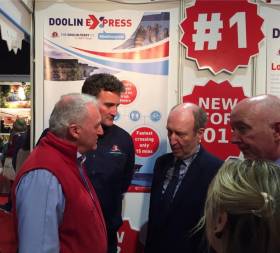Displaying items by tag: Doolin Express
Newest And Fastest: Doolin-Aran Islands Ferry Enters Service
#NewFastFerry- The newest and largest fastferry between Doolin and the Aran Islands has recently begun operations with reduced sailings times by half, writes Jehan Ashmore.
Introduction of Doolin Express is a major advancement in the upgrade of the fleet for Co. Clare based operators Doolin Ferry. The company earlier this year announced the fastest crossings between Doolin and Inis Oírr, the nearest of the Aran Islands to the mainland.
By spending the day taking in the charms of Inis Oírr there is also on the return trip a stunning cruise under the world famous Cliffs of Moher as part of the Wild Atlantic Way. This is the operators most popular cruise option.
Doolin Express is a boost to services having increased capacity of a single ferry of just 100 passengers to the fastferry's 200. The travel experience of Doolin Express also brings passengers in greater comfort given a state of the art electronic stabilising system. This on board technology is to assist passengers that are prone to motion sickness.
In addition to the fastferry improving efficiencies, the newcomer will work towards meeting the operator’s sustainability and environmental goals.
#FastestCrossing – A newly acquired passenger-only ferry is to offer the fastest ever crossing time to the Aran Islands, when Doolin Ferry introduce a highspeed craft just one month after the seasonal service resumes, writes Jehan Ashmore.
Speaking to Afloat at Holiday World Show, Dublin, Liam O’Brien, Director of Doolin Ferries, commented that the 200-passenger ferry, Doolin Express will from April, offer the fastest crossing time to the Aran Islands in just 15 minutes. The new ferry will considerably reduce the journey passage by shaving off 20 minutes from the old 35 crossing time on the Doolin Pier-Inis Oírr service.
The west Clare based operator acquired the fastferry, Blanche Hermine from France operator, Vedettes du Golfe. The craft had served islands in the Golfe du Morbihan, an almost enclosed sea near Vannes in southern Brittany.
Doolin Express will sail at a minimum speed of 19 knots on the service to Inis Oírr, the smallest but closest of the three Aran Islands to the mainland. Neighbouring islands are also served by the company to Inis Meáin and further west Inis Mór, the largest of these Atlantic isles off Galway Bay.
A rival operator also serves from Doolin along with those running from Rossaveal, Connemara and a freight-only link from Galway Port.
When the new ferry, Doolin Express enters service, she will become the largest of the fleet to carry passengers. Tranquility takes 100 passengers and Queen of Aran, a veteran on the west coast service with almost the same capacity.
Doolin Ferry (O’Brien Line) a family run business founded in 1970, also runs excursion trips by Cailin Or with 72 passengers to the spectacular Cliffs of Moher. This location is one of the many highlights dotted along the western seaboard.
In recent years the rugged coast stretching from counties Cork to Donegal has been branded as the Wild Atlantic Way. This has assisted in boosting tourism numbers and notably by targeting overseas visitors.






























































